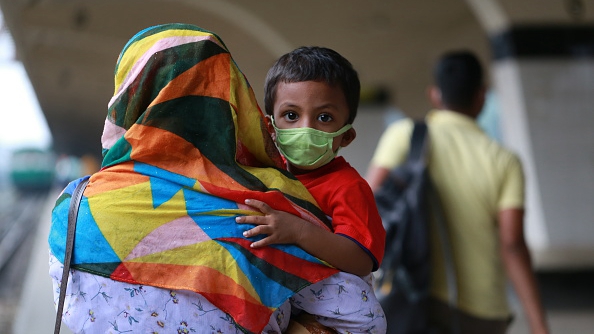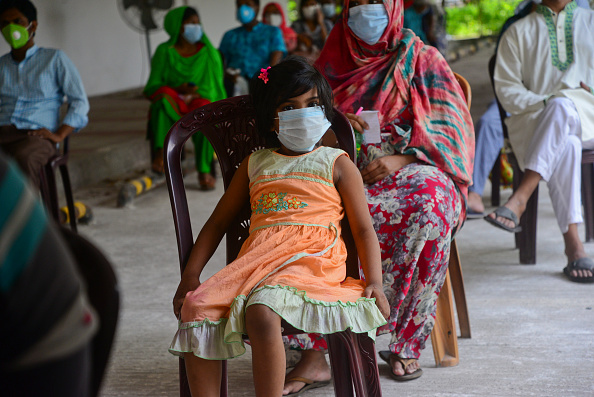
A child seen wearing face mask at Kamolapur railway station in Dhaka, Bangladesh, September 10, 2020. /Getty
A child seen wearing face mask at Kamolapur railway station in Dhaka, Bangladesh, September 10, 2020. /Getty
Editor's note: Samir Saha is head of the Diagnostic Division of Microbiology at the Bangladesh Institute of Child Health and executive director of the Child Health Research Foundation. The article reflects the author's opinions, and not necessarily the views of CGTN.
Last year, a child died of pneumonia every 39 seconds, on average. A form of acute respiratory infection, pneumonia is detectable, treatable, and preventable. Pneumococcal conjugate vaccines (PCVs) – which protect against the bacteria that cause pneumonia and meningitis (a life-threatening brain infection) – have existed since 2000. But their use has been concentrated largely in developed countries, for a simple reason: they are very expensive. Fortunately, a new vaccine could change that.
As it stands, pneumonia disproportionately affects the most vulnerable: children and the elderly, especially those living in developing countries. In 2019, 70 million children were not fully protected by PCVs. More than 80 percent of them lived in Southeast Asia, the Western Pacific, and Africa. This figure may be even higher in 2020, because many of the countries with large populations of unvaccinated children have reported major disruptions to their immunization programs as a result of COVID-19.
Before the pandemic, children in low-income countries were nearly 14 times more likely than children in high-income countries to die before the age of five, owing largely to pneumonia and other acute infections. That rate may be set to rise: new data show that the pandemic-related disruptions to health-care systems and decreased access to food could cause an additional one million child deaths in low- and middle-income countries.
In this context, ensuring broad, affordable access to critical vaccines, including PCVs, is more urgent than ever. After all, vaccines have long proved to be the best tool we have to protect children, particularly in poor and fragile countries, where millions of families lack access to high-quality health-care facilities.
Bangladesh, which introduced PCVs into its national immunization program in 2015, knows the difference a vaccine can make. Thanks to sustained commitment from the government and health officials, the country rapidly implemented a plan to vaccinate nearly every infant in the country.
The results speak for themselves. In less than five years, cases of severe pneumonia among Bangladeshi children have declined by about 50 percent; meningitis cases have also fallen. This is in line with developed countries' experiences: since introducing PCVs, both the United States and the United Kingdom have documented sharp declines in the number of children with severe pneumonia caused by the pneumococcus bacteria.

Residents wait outside the Mugda Medical College and Hospital for their turn to get tested for the COVID-19 coronavirus, in Dhaka, Bangladesh, August 29, 2020. /Getty
Residents wait outside the Mugda Medical College and Hospital for their turn to get tested for the COVID-19 coronavirus, in Dhaka, Bangladesh, August 29, 2020. /Getty
Such progress reflects both direct protection of those who are vaccinated and the development of herd immunity. When the majority of people are vaccinated, the bacteria that cause pneumonia can't spread easily, meaning that people who can't be vaccinated – because they are too young, for example, or have compromised immune systems – are also protected.
By keeping children healthy, pneumococcal vaccines also help to free up additional resources for the health system. In many low-income countries, where hospital beds are limited – and becoming more limited as COVID-19 takes hold – every child who is not in a hospital for pneumonia means that another, with an illness that may not be preventable, can get the treatment they need.
All children deserve the same protection from disease. And that is what a new vaccine, called Pneumosil – approved by the World Health Organization in December 2019, and by the Indian government in July – promises to offer. Manufactured in India, Pneumosil will be available to low-income countries at a price 30 percent lower than what they are currently paying for pneumococcal vaccines. Middle-income countries will also pay less, making Pneumosil the most affordable vaccine of its kind.
In other words, Pneumosil gives developing countries a cost-effective tool to protect vulnerable children, while boosting the dynamism of vaccine markets. With more options for PCVs available than ever before, political leaders, donors, and advocates must seize the opportunity and quickly launch immunization programs wherever they are needed. Failure to do so could mean death for nearly nine million children in the next decade.
When even one child suffers from a preventable disease, it is a tragedy. Allowing millions of children to die from that disease is a crime. We have the tools to save them, and the most powerful of those tools is more accessible than ever before.
Copyright: Project Syndicate, 2020.
(If you want to contribute and have specific expertise, please contact us at opinions@cgtn.com.)